From The CRPG Addict
 |
| I’m playing the second edition of the game. The first is not available anywhere. |
OrbQuest
United States
Alternate World Simulations
Released in 1981 for CP/M
Date Started: 10 March 2020
Date Finished: 15 March 2020
Total Hours: 25
Difficulty: Moderate-Hard (3.5/5)
Final Rating: (to come later)
Ranking at time of posting: (to come later)
Digital Research’s CP/M operating system only boasted two original RPGs, and it turns out that both of them were adapted directly from games on the PLATO mainframe. A year ago,
I covered how
Nemesis (1981) was just a microcomputer version of
Oubliette (1977), and now it’s clear that
OrbQuest is nothing more than a microcomputer version of
The Game of Dungeons (1975), more popularly known by its file name, “DND.” Specifically, it is a direct adaption of the game’s fifth edition.
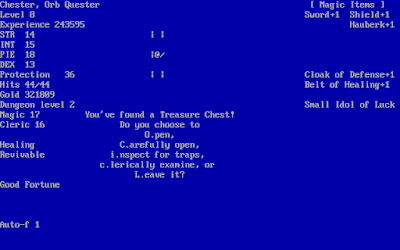 |
Finding a treasure chest in the OrbQuest dungeon offers the same options as The Game of Dungeons.
|
We’ve discussed at length how Daniel Lawrence based his own
DND (c. 1976) on
The Game of Dungeons, but
OrbQuest is a far more literal porting of the code than Lawrence’s. Indeed, if I’d known about it when I won
The Game of Dungeons, I might have been content to discuss
OrbQuest in an addendum rather than playing it as a separate game. Among the things it shares in common:
- A goal to recover an Orb, held by a powerful guardian (a dragon in Game, a “dragon wizard” here)
- Twenty 9 x 9 levels with the same system of movement (e.g., SHIFT to go through a door), secret doors, and one-way doors
- No staircases, just “teleporters” that take you to the next and previous levels, and the teleporters are oddly spaced between squares rather than in them
- The same attributes, with “piety” substituted for “wisdom”
- Experience based on monsters killed and gold retrieved
- Most of the same spells, divided into cleric and mage, with slots given to the character upon leveling
- The same combat options, including minimized importance of “fighting” and each enemy having a particular weakness to a particular spell
- The same commands and results for opening chests, drinking potions, and reading books
- Most of the same items of magical equipment to find
- Most of the same monsters
- On dungeon Level 1, monsters are never higher than Level 1
- Options to toggle on or off automatic collection of gold and automatic fighting of enemies below a certain level
I’m assuming that Dirk Pellet and the other
Game authors didn’t know about this attempt to monetize their work, or certainly they would have objected as strongly as they did to Lawrence’s. Relative obscurity must have helped:
OrbQuest appeared only for a dying platform, and the creator notes on a message board that he only ever sold about 100 copies.
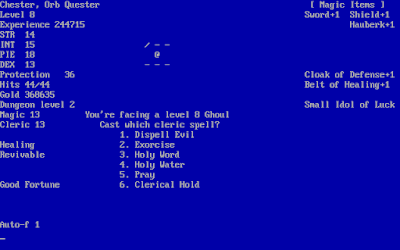 |
| The Game of Dungeons’ cleric spells were, in contrast, “Light Candle,” “Holy Water, “Exorcise,” “Pray,” “Hold,” “Dispell,” and “Datspell.” |
As to that creator, his name was Walter E. Donovan, and his company–existing only for this game, it seems–has an address in Milpitas, California. So far, I have not been able to tie Donovan directly to a PLATO campus (unlike Lawrence and the author of
Nemesis), so I’m not sure how he was exposed to it, but it’s clear that somehow he got the source code or otherwise thorough documentation of its elements and mechanics.
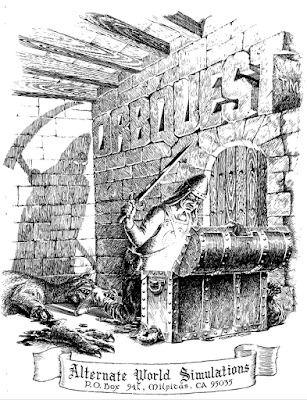 |
| A nice cover leads the game manual, which is otherwise typewritten and photocopied. |
As usual, this is not to say that Donovan added nothing to the game. In fact, he smoothed away some of
Game‘s most egregious imbalances and made the game less random. Gold is less plentiful, particularly on earlier levels, chests (and thus magic items) rarer, and traps less deadly. A player can no longer spend half the game just wandering the same corridors of Level 1 and picking up nearly every magic item along the way. Chests have only about 10 times the gold as random loot on their levels, not 1000 times. Chests aren’t trapped as often, and when they are, they rarely kill you unless you’ve delved too far too fast. Magic items are never trapped. Books and potions help more than they hurt, so it’s worth taking the chance on them.
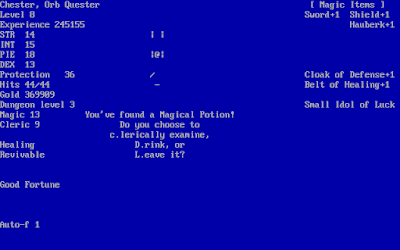 |
| Potions and books are less deadly here than in the source game. |
The result is a game that is, even with permadeath, far more survivable than
The Game of Dungeons but also less “gameable.” There aren’t any tricks to help you get rich quick (unlike in
Game, you can’t cache gold, either) or otherwise bypass the long and tedious process of grinding yourself senseless for a several dozen hours. I’ve been doing it while clearing out my Netflix queue, but I can’t imagine that even back in the day, when it was the only game for my platform, I would have had a lot of fun with it.
 |
| Collecting gold to raise my level. I have a pretty good set of equipment here. |
The game begins with random rolls of 3-18 for strength, dexterity, intelligence, and piety. After that, you begin on Level 1 of the dungeon. The 9 x 9 levels have a fixed layout but a random distribution of gold, chests, and other items, re-randomized every time you change levels or exit the dungeon. Encounters are completely random and also extremely variable. Sometimes, I walked 20 steps or more with no encounters; other times, I had three or four in the same square.
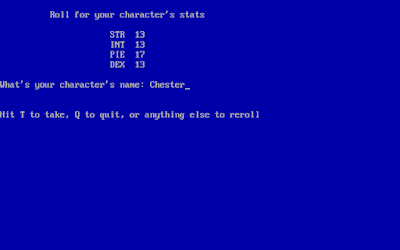 |
| The limited character creation process. |
For the most part, you meet the same monsters on all levels, but the monsters themselves have levels. The monster’s level is far more important in determining his danger than the monster type; that is, a Level 3 ghoul is deadlier than a Level 1 dragon. On dungeon Level 1, monsters are never higher than Level 1 themselves. On other dungeon levels, their levels are randomized to a maximum of roughly 5 times the dungeon level for levels 1-10–unless you’re carrying gold, in which case their maximum level is something like 4 times the dungeon level plus 1 for every 5,000-10,000 gold pieces you carry.
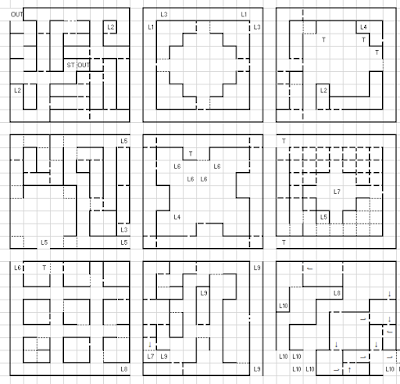 |
| My maps of the first nine levels. |
OrbQuest lacks the “excelsior transport” from Game, but several of the levels have pits that take you directly to lower levels. The levels have varied layouts with secret doors, one-way doors, and such, but no special encounters until Level 10. Playing the game is a process of exploring downward, picking up gold until you start to encounter monsters you can’t handle, then hauling it back up to Level 1 and the exit in order to level up. The next time, you can go a little further and collect a little more gold.
There are 13 monsters in the game: balrogs, deaths, demons, dragons, evil curates, ghouls, green slimes, hirebrands, huge spiders, mindworms, specters, wizards, and zombies. A few of them have special attacks. If mindworms do
any damage to you at all in combat, they’ll sap intelligence permanently. Same goes for specters and strength. Green slimes eat inventory items.
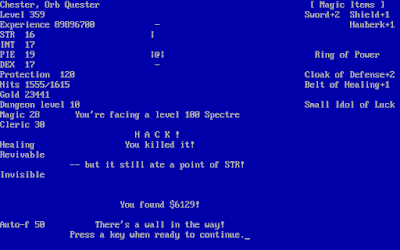 |
| Despite my victory, the specter manages to eat a point of strength. |
As with Game, fighting here is a last resort except for enemies significantly below your level (you can set the game to auto-fight such enemies so you don’t even need to press “F”). Instead, you need to learn, through trial and error, each enemy’s weaknesses to various spells. For instance, balrogs are susceptible to the “Fatal Charm” mage spell. The cleric spell “Holy Water” deals with demons, evil curates, and zombies. As in Game, the cleric’s “Hold” and the mage’s “Sleep” work reliably against enemies below Level 5 and hardly at all after that. As long as the enemy isn’t more than three times your level, he should die immediately from the spell that works best against him. At higher levels, the spell might partly work (depending on the spell), leaving you to finish him off (or vice versa) in melee combat. Again, you can control the level of enemy you face by controlling the amount of gold you carry and the dungeon level you’re visiting.
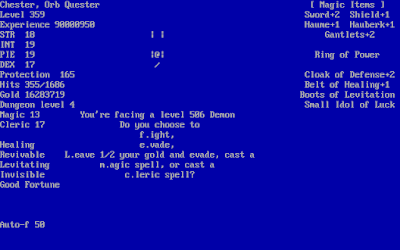 |
| Combat options. |
The occasional potion or tome offers a chance to increase your attributes, and unlike the ones in Game, they don’t have an equal chance of decreasing attributes, although they do have an occasional negative effect like poison or a trap. “Clerical detection” reliably determines if the item is safe.
Chests occasionally deliver magic items. Swords, shields, helms (“haumes”), hauberks, Cloaks of Defense, and Belts of Healing are all initially found at +1, and as you find more, you gain additional pluses. Amulets of Revival will save the character from one death. Small Idols of Luck increase the amount of treasure that you find. Necklaces of Eyes allow you to see secret doors. I was never sure what Rings of Power or Glory did.
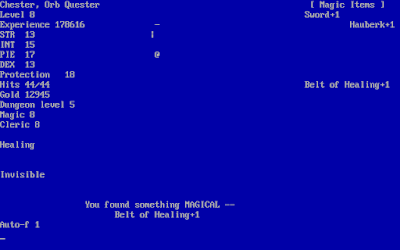 |
| The Belt of Healing is a useful tool that regenerates hit points. |
Level 9 has a bunch of one-way doors that funnel the player to one of the teleporters to Level 10. Immediately on arrival to Level 10, the character is attacked by Demogorgon. This is a test encounter to see if you’re strong enough for the lower levels, and you need to be around Level 100 to beat him. Once he’s dead, he never appears again.
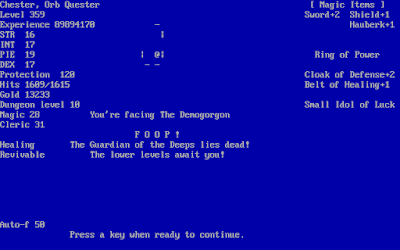 |
| Killing Level 10’s Demogorgon is a key milestone. |
Levels 10-20 are a lot harder. Not only are the monsters much higher level, but there are more navigation obstacles. There are invisible walls, wrapping levels, lots more one-way walls and doors, and other difficult terrain. Downward teleporters sometimes skip two levels. Level 15, with a bunch of concentric squares, is a copy of Game of Dungeons‘ Level 11. Level 16, featuring a spiral of corridors, is a copy of Game‘s Level 15. And Level 17, with a bunch of featureless north/south corridors connected by secret doors, is a copy of Game‘s Level 20.
The Dragon Wizard is found somewhere on Level 20. The level has a couple of squares that halve your available spells and another one that blinds you. If you defeat the Dragon Wizard, you get the Orb and millions of gold pieces–which it would be sensible to immediately drop, as the Orb itself is going to attract enough high-level monsters. You then have to make your way back up 20 levels, apparently somewhere encountering The Grim Reaper, who’s even harder than the Dragon Wizard.
Here is where I run into problems. Although I’ve explored them both multiple times, I cannot find the up teleporters from Levels 19 or 13. A “Teleport” spell that’s supposed to move you upward for one cleric and one mage spell slot absolutely never works. Thus, although I have managed to obtain the Orb, I can’t find my way out of the dungeon.
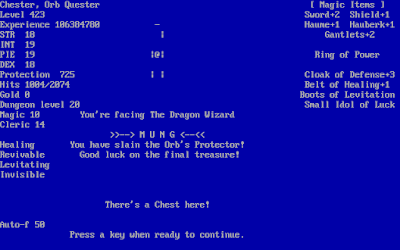 |
| I had the Orb at one point; I just couldn’t get it out. |
I haven’t been adhering to permadeath, of course. The game makes it easy to cheat. It saves your character with every level transition and doesn’t record his “death” until you acknowledge the death message. This is an opportunity for players to quickly remove the disk from the drive, or in my case kill the emulator. Reloading is a pain, though, so death still has consequences. Since I’m emulating the CP/M from within DOSBox, I have to restart two emulators with their associated commands and sit through a timer in the unregistered CP/M emulator. It was probably easier for a 1981 player to restart his game than it is for me.
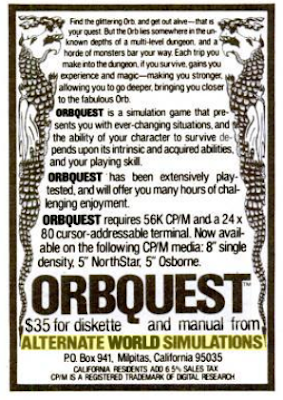
Thus, having wasted an absurd number of hours on the game, I can’t show you a winning screen. But if I know my readers, one of them will eventually grow curious enough to poke around in the game’s code and let me know what I missed, and I’ll be able to come back with an addendum. For now, the game ties with Game for an 18, although the individual stories aren’t exactly the same. Game of Dungeons at least tried to make up a story about the dungeon, which OrbQuest doesn’t, but OrbQuest has a slightly better variety of equipment.
 |
| OrbQuest gets some credit for slightly more gruesome combat language than its source. |
We’ll take our second look at Planet’s Edge next while I gear up to plan fan (and Addict) favorite Ultima VII. Replacing it on the “upcoming” list is Catacombs (1982) for the ZX81, for which I haven’t even found an emulator yet, so we’ll see.
Original URL: http://crpgaddict.blogspot.com/2020/03/game-362-orbquest-1981.html















